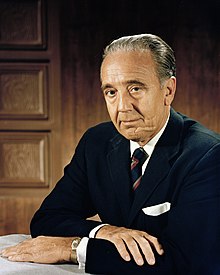Kurt Debus | |
|---|---|
 Debus' official portrait as KSC director | |
| Born | Kurt Heinrich Debus November 29, 1908 |
| Died | October 10, 1983 (aged 74) Rockledge, Florida, U.S. |
| Alma mater | 1933 BS, 1935 MS, 1939 PhD; Technische Hochschule Darmstadt 1967 Doctor of Laws, Rollins College (honorary) |
| Known for | first Kennedy Space Center director |
| Spouse |
Irmgard Brueckmann (m. 1937) |
| Children | 2 |
| Awards | 1969: National Space Hall of Fame[1] 1967: Space Flight Award (AAS) Schutzstaffel (SS) Instrument Society of America (honorary) Hermann-Raketentechnik and Raumfahrt, e.V. (honorary) Marquis Biographical Library Society (advisory) Member of the Florida Council of 100 (ex officio) British Interplanetary Society (Advisory Board) American Ordnance Association (life) |
| Scientific career | |
| Fields | Electrical engineering[3] |
| Institutions | Voight & Haeffner, AG (Frankfurt)[4] 1939–1943:[4] Technische Hochschule Darmstadt (assistant professor) |
Kurt Heinrich Debus[3] (November 29, 1908 – October 10, 1983) was a German-American rocket engineer and NASA director. Born in Germany, he was a member of the Schutzstaffel (SS) during World War II, where he served as a V-weapons flight test director. Following the war, he was brought to the United States via Operation Paperclip, and directed the design, development, construction and operation of NASA's Saturn launch facilities. He became the first director of NASA's Launch Operations Center (later renamed as the Kennedy Space Center), and, under him, NASA conducted 150 launches of military missiles and space vehicles, including 13 launches of the Saturn V rocket as part of the Apollo Moon landing program.
- ^ Cite error: The named reference
NASA2was invoked but never defined (see the help page). - ^ The Scott Gold Medal is awarded by the American Ordnance Association's Missile and Astronautics division.
- ^ a b c Cite error: The named reference
Darlingwas invoked but never defined (see the help page). - ^ a b Cite error: The named reference
McCleskeywas invoked but never defined (see the help page). - ^ "Biographies of Aerospace Officials and Policymakers, A-D". NASA History Division. Archived from the original on November 10, 2017. Retrieved October 18, 2008.
- ^ Leitenburger, Bernd. "OTRAG Rocket". Retrieved December 20, 2022.